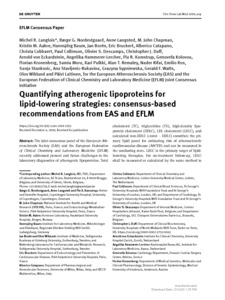Langlois, MR;
Nordestgaard, BG;
Langsted, A;
Chapman, MJ;
Aakre, KM;
Baum, H;
Borén, J;
Bruckert, E;
Catapano, A;
Cobbaert, C;
et al.
Langlois, MR; Nordestgaard, BG; Langsted, A; Chapman, MJ; Aakre, KM; Baum, H; Borén, J; Bruckert, E; Catapano, A; Cobbaert, C; Collinson, P; Descamps, OS; Duff, CJ; von Eckardstein, A; Hammerer-Lercher, A; Kamstrup, PR; Kolovou, G; Kronenberg, F; Mora, S; Pulkki, K; Remaley, AT; Rifai, N; Ros, E; Stankovic, S; Stavljenic-Rukavina, A; Sypniewska, G; Watts, GF; Wiklund, O; Laitinen, P; European Atherosclerosis Society (EAS) and the European Federati
(2020)
Quantifying atherogenic lipoproteins for lipid-lowering strategies: consensus-based recommendations from EAS and EFLM.
Clin Chem Lab Med, 58 (4).
pp. 496-517.
ISSN 1437-4331
https://doi.org/10.1515/cclm-2019-1253
SGUL Authors: Collinson, Paul
![[img]](https://openaccess.sgul.ac.uk/111671/1.hassmallThumbnailVersion/%5BClinical%20Chemistry%20and%20Laboratory%20Medicine%20%28CCLM%29%5D%20Quantifying%20atherogenic%20lipoproteins%20for%20lipid-lowering%20strategies%20consensus-based%20recommendations%20from%20EAS%20and%20EFLM.pdf)  Preview |
|
PDF
Published Version
Available under License ["licenses_description_publisher" not defined].
Download (550kB)
| Preview
|
Abstract
The joint consensus panel of the European Atherosclerosis Society (EAS) and the European Federation of Clinical Chemistry and Laboratory Medicine (EFLM) recently addressed present and future challenges in the laboratory diagnostics of atherogenic lipoproteins. Total cholesterol (TC), triglycerides (TG), high-density lipoprotein cholesterol (HDLC), LDL cholesterol (LDLC), and calculated non-HDLC (=total - HDLC) constitute the primary lipid panel for estimating risk of atherosclerotic cardiovascular disease (ASCVD) and can be measured in the nonfasting state. LDLC is the primary target of lipid-lowering therapies. For on-treatment follow-up, LDLC shall be measured or calculated by the same method to attenuate errors in treatment decisions due to marked between-method variations. Lipoprotein(a) [Lp(a)]-cholesterol is part of measured or calculated LDLC and should be estimated at least once in all patients at risk of ASCVD, especially in those whose LDLC declines poorly upon statin treatment. Residual risk of ASCVD even under optimal LDL-lowering treatment should be also assessed by non-HDLC or apolipoprotein B (apoB), especially in patients with mild-to-moderate hypertriglyceridemia (2-10 mmol/L). Non-HDLC includes the assessment of remnant lipoprotein cholesterol and shall be reported in all standard lipid panels. Additional apoB measurement can detect elevated LDL particle (LDLP) numbers often unidentified on the basis of LDLC alone. Reference intervals of lipids, lipoproteins, and apolipoproteins are reported for European men and women aged 20-100 years. However, laboratories shall flag abnormal lipid values with reference to therapeutic decision thresholds.
| Item Type: |
Article
|
| Additional Information: |
© 2019 Walter de Gruyter GmbH, Berlin/Boston. |
| Keywords: |
LDL cholesterol, apolipoprotein B, atherosclerotic cardiovascular disease, lipoprotein(a), non-HDL cholesterol, remnant cholesterol, European Atherosclerosis Society (EAS) and the European Federation of Clinical Chemistry and Laboratory Medicine (EFLM) Joint Consensus Initiative, General Clinical Medicine, 1103 Clinical Sciences, 1702 Cognitive Sciences |
| SGUL Research Institute / Research Centre: |
Academic Structure > Molecular and Clinical Sciences Research Institute (MCS) |
| Journal or Publication Title: |
Clin Chem Lab Med |
| ISSN: |
1437-4331 |
| Language: |
eng |
| Dates: |
| Date | Event |
|---|
| 26 March 2020 | Published | | 19 December 2019 | Published Online | | 4 December 2019 | Accepted |
|
| Publisher License: |
Publisher's own licence |
| PubMed ID: |
31855562 |
 |
Go to PubMed abstract |
| URI: |
https://openaccess.sgul.ac.uk/id/eprint/111671 |
| Publisher's version: |
https://doi.org/10.1515/cclm-2019-1253 |
Statistics
Item downloaded times since 14 Feb 2020.
Actions (login required)
 |
Edit Item |



